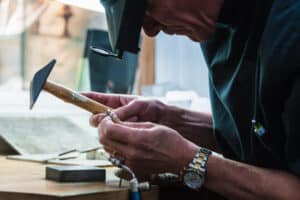As even the most casual precious metals investor will tell you, counterfeit gold scams aren’t anything new. However, the means and methods that gold scammers are using continue to become more high-tech and even more difficult to detect. Keep reading to learn more about some of the methods modern scammers are using and what you can do to protect yourself from counterfeit gold scams.
What Are The Most Commonly Counterfeited Gold Products?
Counterfeit gold products are deceptively sold as genuine gold when, in reality, they are composed of inferior metals or alloys. Gold coins and gold bars are common targets for forgery due to their high value and widespread recognition. Examples of counterfeit gold items include:
- Gold-plated Coins and Bars: These are often composed of a core of cheaper metal like copper, brass, or bronze, only covered with a thin layer of gold.
- Fake Gold Sovereigns: These are imitation coins intended to mimic genuine gold sovereign coins from the UK, known for their historical value.
- Counterfeit Krugerrands: Originating from South Africa, these gold coins are frequently forged with less valuable materials.
- Imitations of American Gold Eagles: A popular investment coin in the U.S., it is also a frequent target for counterfeiters looking to exploit its popularity.
Keep in mind this list is not exhaustive in the least – gold scammers are constantly finding new products to counterfeit and methods to produce their counterfeits. Counterfeiters do tend to target well-known brands and certificates to give the impression of authenticity, so don’t let your guard down just because of a brand name. Always make sure to verify the gold’s purity, weight, and authenticity through a reputable dealer to ensure you’re actually getting what you’ve paid for.
Modern Gold Counterfeiting Techniques
Counterfeiters employ a variety of sophisticated methods to duplicate the appearance and feel of genuine gold products. They often target gold coins and bars, which are easier to sell to unsuspecting buyers. Here, we discuss some prevalent techniques used in modern gold counterfeiting.
Advanced Chemical Compounds & Alloys
Counterfeiters often use advanced chemical compounds and alloys that mimic the density and weight of gold. These materials are designed to pass basic tests such as weight and size checks. They may mix gold with other metals to create an alloy that closely resembles pure gold to the untrained eye.
Tungsten-Filled Gold Bars
Tungsten has a similar density to gold, making it an ideal material for the core of fake gold bars. Counterfeiters encase a tungsten core in a thin layer of gold. This type of counterfeit can sometimes pass through surface tests, making it critical for buyers to verify the gold content throughout the item, not just at the surface.
Gold Casting & Striking
Fake gold coins can be produced through casting or striking. In casting, counterfeiters pour molten metal into molds. For striking, they press metal blanks with dies to create coin designs. Both methods require skill to ensure the coins mimic legitimate ones in design and detail.
Electroplating & Molecular Plating
Electroplating involves coating a base metal with a thin layer of gold using electrical currents. Molecular plating is a more advanced variation where gold is deposited on a molecular level. These techniques can create products that look like gold on the outside but have little to no actual gold content.
Gold Plating
The most basic form of counterfeiting is gold plating. Counterfeiters apply a very thin layer of gold over a base metal, resulting in a product that appears to be solid gold. However, the gold layer is often only a few microns thick and can quickly wear off or be removed to reveal the base metal beneath.
Ways To Identify Counterfeit Gold
There are a number of ways to identify counterfeit gold – the right one depends on the method that was used to produce the fake precious metals. If you plan to buy gold from an unlicensed dealer or private dealer in a private sale, it’s important to perform an array of tests on the product before you make the transaction.
Visual Inspections
When examining gold to determine its authenticity, a visual inspection is a crucial first step. Authentic gold items typically bear hallmarks indicating their purity, manufacturer, and sometimes the place and year of manufacture. These hallmarks are a form of consumer protection, assuring the buyer of the quality and fineness of the metal. In contrast, counterfeit gold may have incorrect, inconsistent, or absent hallmarking. It is important to familiarize oneself with the hallmarking standards of the specific country, as these can vary.
However, counterfeiters sometimes replicate these marks to deceive buyers, so while hallmarking is a good indicator, it should not be the sole method of verification. Other visual cues include examining the wear and tear of the item. Gold is a soft metal, so genuine gold items might show a different pattern of wear compared to harder counterfeit materials. Additionally, the overall craftsmanship can be a telltale sign; genuine gold items often have a high level of detail and finish that counterfeit pieces lack.
Examine Weight and Size
The physical properties of gold, particularly its density, are a reliable way to check for authenticity. Gold is one of the densest metals, and this high density means that a small piece of gold will be surprisingly heavy. Counterfeit gold items may look the part but often fail to have the correct weight for their size, a discrepancy that can be detected with precise scales. If an item’s weight significantly deviates from the weight that is expected for its volume, this can be a strong indication that it may not be made of real gold.
To conduct a weight and size test, you can compare the item in question to a piece of gold with known dimensions and mass. If the suspect item has the same dimensions but a significantly lighter weight, it is likely not made of pure gold. It’s important to consider that some counterfeit gold items may contain a core of a different metal that is denser than typical base metals to mimic gold’s weight more closely. Therefore, weight should also be assessed in conjunction with other tests and not be used in isolation to determine gold authenticity.
Ping Test
The ping test is a simple and non-destructive method to help verify the authenticity of gold coins. Genuine gold coins, when struck against another hard surface or with a metal object, will produce a distinctive ringing sound that lasts for approximately 1-2 seconds. The sound is clear and high-pitched due to gold’s high density and elasticity. In contrast, counterfeit coins may produce a duller sound with a shorter resonance, as alternative metals or alloys typically do not have the same acoustic properties as gold.
This test can be performed easily at home or by a dealer. It’s important to note, however, that while the ping test can be indicative of authenticity, it is not foolproof. Some counterfeit coins are sophisticated enough to mimic the sound properties of gold, so this method should be used in conjunction with other tests. For the best results, individuals may compare the sound of a known genuine gold coin with that of the suspect coin to detect any discrepancies.
Ultrasonic Testing
Ultrasonic testing provides a more technical approach to verifying the authenticity of gold. This non-destructive method utilizes high-frequency sound waves that are passed through the metal. Genuine gold will have a consistent, uniform wave velocity profile, which is a measure of how fast sound waves travel through the metal. Variations in this profile can indicate the presence of different materials or alloys, suggesting that the item may not be made of pure gold.
Specialized ultrasonic testing equipment is required to perform this analysis, making it less accessible for the average person. However, it is a powerful tool for professionals who need to validate the authenticity of gold without causing any damage to the item. The equipment measures the thickness of the gold item and the speed at which the sound waves travel through it. Any significant deviations from the expected values for pure gold could signal a counterfeit. It’s worth noting that while ultrasonic testing is highly accurate, it should still be used alongside other verification methods for the most reliable results.
Scratch Tests
Scratch tests are one of the more traditional methods used to determine the purity and authenticity of gold. To perform a scratch test, you would use a non-glazed ceramic plate or a piece of unglazed porcelain tile. The gold item is scratched against the ceramic, leaving a streak of gold on the surface. The color of the streak left by the gold can give an indication of its purity.
Genuine gold leaves a golden yellow streak, whereas counterfeit items composed of lower-quality metals or alloys will leave a black or green streak. This is because genuine gold is soft and will leave a mark, whereas other metals that might be used to simulate gold are harder and will not leave the correct color streak or any streak at all.
However, the scratch test is somewhat invasive and can damage the gold item, leaving a mark where the metal has been scratched off. For this reason, it is recommended to scratch the item in an inconspicuous area. The test is also not foolproof; some gold-plated items might still leave a gold-colored streak, potentially leading to a false positive for authenticity. To confirm the results, a drop of testing acid can be applied to the streak.
The acid is formulated to react with different purities of gold, so observing the reaction can help determine the item’s authenticity and karat rating. If the streak dissolves or changes color when the acid is applied, this indicates that the metal is not pure gold. However, it’s important to handle acids with care and to follow proper safety protocols when performing this test.
Recent Reports Of Counterfeit Gold Scams Across The Nation
As the wave of counterfeit gold scams continues to rise, it’s important to remember that in the world of gold buying and selling, caution, due diligence, and a healthy dose of skepticism can be the best defense against falling victim to these scams.
Spokane Pawn Shops Warn Customers About Fake Gold Scams
Dug Karlson, owner of Axel’s Pawn Shop in Spokane, Washington, has witnessed firsthand the unsettling uptick in counterfeit gold scams. In response to this growing trend, Karlson has taken proactive measures to protect his customers and maintain the integrity of transactions at Axel’s Pawn Shop. He’s implemented an authenticity verification program, a rigorous process to determine the authenticity of all precious metal items offered for sale in his store.
Under this program, no purchase or sale transaction is completed until each item has undergone a comprehensive verification process. This thorough approach ensures that every gold item that passes through Axel’s Pawn Shop is genuine, increasing customer confidence in the store’s transactions.
Karlson has issued a strong warning to all customers, stressing the importance of being vigilant against fraudulent individuals peddling counterfeit gold under the guise of needing urgent financial assistance.
Elaborate Fake Gold Scam Narrowly Costs Massachusetts Woman Her Life Savings
In 2020, an elderly woman was manipulated by scammers to convert her entire savings into what she believed would be a substantial gold fortune. Unfortunately, this was a well-crafted illusion to rob her of her money.
The scammers, who were later found to have connections with international drug trafficking, didn’t stop at just robbing her of her savings. They also seized her bank accounts, leaving her in a state of financial ruin. It was a shockingly audacious act highlighting the ruthless lengths these criminals were willing to commit.
Fortunately, the main perpetrator of this scandal was eventually caught and sentenced to prison. But this small victory was little consolation to the victim, who had to deal with the devastating financial consequences.
Washington State Patrol Data Shows An Increase In Gold Scammers
Since May 2020, a disturbing 374 separate incidents involving the sale of counterfeit gold have been recorded throughout Washington. This rising trend underscores the need for increased vigilance and awareness among potential investors and the general public.
These scams follow a specific pattern. Often well-dressed and using high-end rental vehicles for credibility, the perpetrators stop unsuspecting motorists on rural roads. They then entice their victims to buy what they believe to be genuine gold jewelry, which later turns out to be counterfeit.
The financial impact is significant, with victims reporting losses of approximately $1,000 per incident. In response to this escalating problem, Washington State Patrol investigators are working hard to apprehend the individuals involved.
Gaurang Contractor Pleads Guilty In Wire Fraud Counterfeit Gold Conspiracy
Gaurand Contractor had lived in Jersey City, New Jersey, where he orchestrated an elaborate scam involving counterfeit gold. He conducted his fraudulent activities under the false pretense of being a Drug Enforcement Administration (DEA) agent.
Contractor’s scam targeted unsuspecting individuals whom he convinced to invest their hard-earned money into what they believed were lucrative precious metal investments. However, the promised gold was non-existent, and the investments were nothing more than a carefully crafted illusion.
However, thanks to the tireless efforts of investigators, Contractor’s fraudulent operation was eventually uncovered and brought to an end. On March 27, 2023, facing overwhelming evidence of his fraudulent actions, Contractor confessed to his crimes and pleaded guilty to one count of conspiracy to commit wire fraud.
U.S. Customs And Border Protection Counterfeit Gold Seizures
In 2021, U.S. Customs and Border Protection (CBP) officers at LAX intercepted a shipment from Mexico that was found to contain counterfeit gold bars. The estimated worth of these fraudulent bars was over $20,000, which could have caused significant financial damage had they made their way into the market.
The shipment was meticulously packed to avoid detection, with the counterfeit gold bars skillfully designed to mimic the appearance of genuine gold. However, the CBP officers at LAX, trained to spot such fraudulent items, successfully identified and confiscated the counterfeit gold.
Ways To Protect Yourself From Counterfeit Gold Scams
When considering an investment in gold or any precious metal, your best bet is always to use a reputable gold dealer. However, if you do plan to purchase precious metals from a private seller, here are some tips on how to protect yourself from falling victim to gold scams:
- To state it again – always buy gold from reputable and established dealers. These dealers have a good reputation and are less likely to sell fake gold. They also often offer guarantees of authenticity.
- Check if the dealer is certified by industry associations such as the Professional Numismatists Guild or the American Numismatic Association. Dealers with such certifications adhere to strict standards of professionalism and ethics.
- If an offer seems too good to be true, it probably is. Be wary of gold that is being sold well below market value.
- Genuine gold items usually have markings indicating their purity. Familiarize yourself with these markings to better identify real gold.
- Consider having major purchases appraised by an independent expert. An appraiser can determine if the gold is real and worth the price you paid.
- Be wary of sellers who pressure you or push you to buy. This is often a red flag for a possible scam.
- Knowledge is power. Educate yourself about gold, its properties, and how to verify its authenticity. There are many sources on the Internet and in print to help you become a better-informed buyer.
Questions To Ask Before Buying Gold
Before investing in gold, be sure to ask the right questions to avoid falling victim to a scam. Some important points to keep in mind include:
- Inquire about the origin of the gold. Scammers often struggle to provide credible information.
- Inquire if the dealer is licensed or registered with a competent authority. Reputable dealers are usually willing to provide proof of their credentials.
- Request a certificate of purity and weight from an independent testing agency. These documents confirm the quality and quantity of the gold being sold.
- Inquire about the return policy and make sure you fully understand it before proceeding with an investment.
- Research the market value and prices so you don’t fall for overpriced goods or services.
- Find out if any follow-up services are included with the investment, such as storage or insurance coverage.
Buying Gold From SpaceXgold
Despite the recent growing concern of gold scams, SpaceXgold prides itself on our customer-centric approach, offering personalized service to meet every investor’s unique needs. Don’t just take our word for it, though; here are several of SpaceX Gold Investment’s most recent reviews so you can learn what it’s like to work with us directly from our clients.
We provide a range of investment options, from physical gold, silver, and platinum that you can store at home to gold and silver IRA options for tax-advantaged retirement investing. Give us a call today at . to speak to one of our customer support professionals, or click here to open an account yourself. Our representatives are ready to answer your questions and get you started investing in gold and other precious metals.






